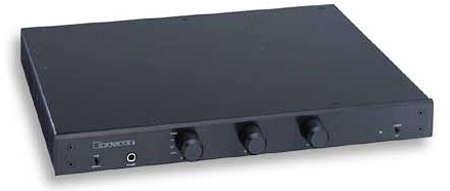| Columns Retired Columns & Blogs |
Bryston B-60R integrated amplifier

Bryston is one of North America's most established hi-fi makers. Based not far from Toronto in Peterborough, Ontario, Bryston has been in business since 1962.
Footnote 1: Dual power supplies are standard with the B-60, not an optional extra as they are with the YBA Integré.—Sam Tellig
But audiophiles don't get excited about Bryston—not, at least, those hard-core audiophiles who love to keep changing equipment, who think of hi-fi as a competitive sport. Bryston! Why, their 2B amplifier has been in production for almost 20 years! How boring.
How boring, too, the fact that Bryston equipment is now guaranteed for 20 years. Who owns something for 20 years? (Bryston customers, obviously.) My buddy The Brass Ear is unlikely to own a piece of equipment for 20 weeks. ("Twenty days!" said Brass Ear when I read this to him. "Twenty hours. Minutes!")
With Bryston gear, you get solid engineering and impeccable—I was going to say unimpeachable—build quality. This is what you pay for; not bulletproof faceplates, gold-plated name badges, or the like. Because Bryston gear is not overbuilt, it's not overpriced. Being made in Canada also helps, now that NAFTA has kicked import duties down to nearly nil. And Bryston's US importer is Bryston, so the stuff can be very keenly priced.
The B-60 is Bryston's first integrated amplifier. Without remote, it'll set you back $1495; with remote, $1795. Before you fork over the extra $300 for the remote, be aware that it only controls volume and mutes—that's it. It doesn't change source or adjust channel balance. It won't control your CD player.
There is no onboard phono option. If you want to do phono through the Bryston, that could cost you almost as much as the B-60 itself. The BP-1 phono stage—rumored to be excellent—runs $750. Add $550 for an outboard TF-1 transformer for low-output moving-coils.
Fortunately, there are plenty of decent outboard phono stages available for less money—for instance, the $199 Creek OBH-8 moving-magnet phono stage or $249 OBH-9 moving-coil phono stage, neither of which Music Hall's Roy Hall has bothered to send me, but both of which are said (by independent sources) to be quite good...
The B-60 is remarkably small—a standard 17" wide by only 2" tall—so you can squeeze it into tight spaces. It's a black box, plainly but elegantly styled in a way that reminds me of the Advent receiver of more than 20 years ago. The Bryston is far better built. (The Advent 300 had high-end sound, but not high-end build quality.)
Essentially, the B-60 combines in one chassis two Bryston separates—the aforementioned 60Wpc 2B power amp and the BP-20 preamp. "The 2B amplifier has long been a customer favorite because of its sweetness and transparency," said Chris Russell, Bryston's Vice President of Engineering. Like the 2B, the B-60's power-amp section uses two bipolar transistors per channel. These are closely computer-matched, according to Chris, as they are for Bryston's separate power amps.
"Not many integrated amplifiers have dual power supplies (footnote 1). Nor do they use as expensive or refined a preamp section as we do," said Chris. "The B-60 benefits from all the research that went into the B-20, which was heavily researched, the aim being to devise a circuit path which has very low distortion and very low noise."
So what about the advantages of producing an integrated amp, as opposed to a separate preamp and power amp?
"There's the obvious saving because you assemble one chassis, not two." Chris took a deep breath before continuing. "You also get the sonic advantages of eliminating the concept of interconnect cables."
"Fine by me," I replied.
"All this controversy about cables tends to lead people down the wrong path," he continued. "People talk about how cables sound. Well, obviously, cables shouldn't have a 'sound.' There shouldn't be anything you can pin down as to what a cable is doing to a system. If it's doing anything, it's doing something that shouldn't be there."
"Let's tell Jonathan Scull," I said. "You save all this money on interconnects and you can put it toward a Shakti stone...or a set of Shun Mook Mpingo discs. Or maybe some audiophile feet—all the tweaks that C. Victor Campos, of Adcom, refers to as 'magic shit.'"
Chris fell silent.
"What about having both chassis at the same ground point? Any advantage there?"
Chris revived. "Yes. Two different chassis are going to be at two different ground points, even if the difference is small. With the B-60, you have one starground for everything. That helps reduce hum."
Hmmmmmm.
The RCA jacks on the back are high-quality, gold-plated, and Teflon-insulated. There's only one pair of speaker terminals, but these are particularly well-designed, with a ridge in the center to prevent positive and negative wires from accidentally touching and shorting the amp. Typical Bryston touch.
Remove the top cover and you'll see that the circuitry is all discrete: There are no integrated circuits, which Chris feels would compromise sound quality. "The problem with ICs," said Chris, "is you can't get them to sound consistently good." Signal paths are short, and the layout of the amp is clutter-free. Remember, Bryston guarantees the product for 20 years.
"Twenty years!" exclaimed Brass Ear. "Imagine holding the same piece of stereo equipment for 20 years."
"Some people do. I'd keep a car for 20 years if I could. As it is, I keep a car for only 10." (I was needling Brass Ear, who sells cars—but not to me.)
The Bryston B-60 has four line-level inputs and a tape loop. The preamp and power-amp sections are connected by a pair of solid jumpers, allowing you to leave the preamp and come back into the power amp—handy if you want to use a surround-sound processor.
Footnote 1: Dual power supplies are standard with the B-60, not an optional extra as they are with the YBA Integré.—Sam Tellig
- Log in or register to post comments



































